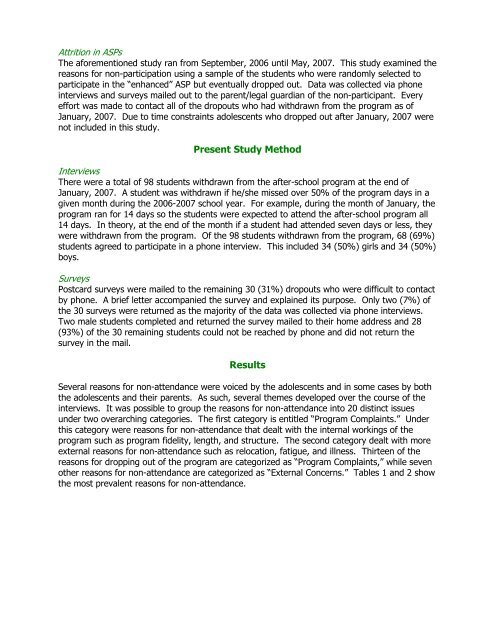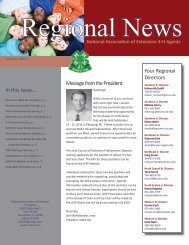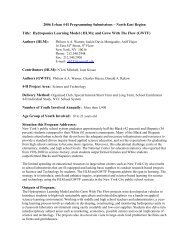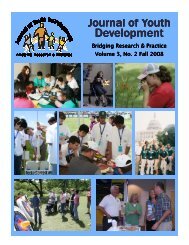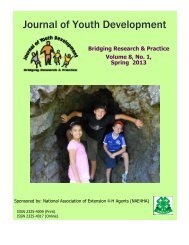Winter 2008 - Vol. 3 No. 3 - National Association of Extension 4-H ...
Winter 2008 - Vol. 3 No. 3 - National Association of Extension 4-H ...
Winter 2008 - Vol. 3 No. 3 - National Association of Extension 4-H ...
- No tags were found...
Create successful ePaper yourself
Turn your PDF publications into a flip-book with our unique Google optimized e-Paper software.
Attrition in ASPsThe aforementioned study ran from September, 2006 until May, 2007. This study examined thereasons for non-participation using a sample <strong>of</strong> the students who were randomly selected toparticipate in the “enhanced” ASP but eventually dropped out. Data was collected via phoneinterviews and surveys mailed out to the parent/legal guardian <strong>of</strong> the non-participant. Everyeffort was made to contact all <strong>of</strong> the dropouts who had withdrawn from the program as <strong>of</strong>January, 2007. Due to time constraints adolescents who dropped out after January, 2007 werenot included in this study.Present Study MethodInterviewsThere were a total <strong>of</strong> 98 students withdrawn from the after-school program at the end <strong>of</strong>January, 2007. A student was withdrawn if he/she missed over 50% <strong>of</strong> the program days in agiven month during the 2006-2007 school year. For example, during the month <strong>of</strong> January, theprogram ran for 14 days so the students were expected to attend the after-school program all14 days. In theory, at the end <strong>of</strong> the month if a student had attended seven days or less, theywere withdrawn from the program. Of the 98 students withdrawn from the program, 68 (69%)students agreed to participate in a phone interview. This included 34 (50%) girls and 34 (50%)boys.SurveysPostcard surveys were mailed to the remaining 30 (31%) dropouts who were difficult to contactby phone. A brief letter accompanied the survey and explained its purpose. Only two (7%) <strong>of</strong>the 30 surveys were returned as the majority <strong>of</strong> the data was collected via phone interviews.Two male students completed and returned the survey mailed to their home address and 28(93%) <strong>of</strong> the 30 remaining students could not be reached by phone and did not return thesurvey in the mail.ResultsSeveral reasons for non-attendance were voiced by the adolescents and in some cases by boththe adolescents and their parents. As such, several themes developed over the course <strong>of</strong> theinterviews. It was possible to group the reasons for non-attendance into 20 distinct issuesunder two overarching categories. The first category is entitled “Program Complaints.” Underthis category were reasons for non-attendance that dealt with the internal workings <strong>of</strong> theprogram such as program fidelity, length, and structure. The second category dealt with moreexternal reasons for non-attendance such as relocation, fatigue, and illness. Thirteen <strong>of</strong> thereasons for dropping out <strong>of</strong> the program are categorized as “Program Complaints,” while sevenother reasons for non-attendance are categorized as “External Concerns.” Tables 1 and 2 showthe most prevalent reasons for non-attendance.


